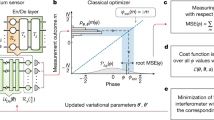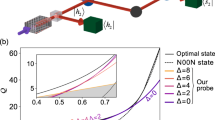Abstract
Special quantum states are used in metrology to achieve sensitivities below the limits established by classically behaving states1,2. In bosonic interferometers, squeezed states3, number states4,5 and ‘Schrödinger cat’ states5 have been implemented on various platforms and have demonstrated improved measurement precision over interferometers using coherent states6,7. Another metrologically useful state is an equal superposition of two eigenstates with maximally different energies; this state ideally reaches the full interferometric sensitivity allowed by quantum mechanics8,9. Here we demonstrate the enhanced sensitivity of these quantum states in the case of a harmonic oscillator. We extend an existing experimental technique10 to create number states of order up to n = 100 and to generate superpositions of a harmonic oscillator ground state and a number state of the form \(\frac{1}{\sqrt{2}}\left(\left|0\right\rangle +\left|n\right\rangle \right)\) with n up to 18 in the motion of a single trapped ion. Although experimental imperfections prevent us from reaching the ideal Heisenberg limit, we observe enhanced sensitivity to changes in the frequency of the mechanical oscillator. This sensitivity initially increases linearly with n and reaches a maximum at n = 12, where we observe a metrological enhancement of 6.4(4) decibels (the uncertainty is one standard deviation of the mean) compared to an ideal measurement on a coherent state with the same average occupation number. Such measurements should provide improved characterization of motional decoherence, which is an important source of error in quantum information processing with trapped ions11,12. It should also be possible to use the quantum advantage from number-state superpositions to achieve precision measurements in other harmonic oscillator systems.
This is a preview of subscription content, access via your institution
Access options
Access Nature and 54 other Nature Portfolio journals
Get Nature+, our best-value online-access subscription
$29.99 / 30 days
cancel any time
Subscribe to this journal
Receive 51 print issues and online access
$199.00 per year
only $3.90 per issue
Buy this article
- Purchase on Springer Link
- Instant access to full article PDF
Prices may be subject to local taxes which are calculated during checkout




Similar content being viewed by others
Data availability
The datasets generated or analysed during the current study are available from the corresponding author on reasonable request.
References
Pezzè, L., Smerzi, A., Oberthaler, M. K., Schmied, R. & Treutlein, P. Quantum metrology with nonclassical states of atomic ensembles. Rev. Mod. Phys. 90, 035005 (2018).
Braun, D. et al. Quantum-enhanced measurements without entanglement. Rev. Mod. Phys. 90, 035006 (2018).
Caves, C. M., Thorne, K. S., Drever, R. W. P., Sandberg, V. D. & Zimmermann, M. On the measurement of a weak classical force coupled to a quantum-mechanical oscillator. I. Issues of principle. Rev. Mod. Phys. 52, 341–392 (1980).
Boto, A. N. et al. Quantum interferometric optical lithography: exploiting entanglement to beat the diffraction limit. Phys. Rev. Lett. 85, 2733–2736 (2000).
Haroche, S. & Raymond, J.-M. Exploring the Quantum (Oxford University Press, 2006).
Schrödinger, E. Der stetige Übergang von der Mikro- zur Makromechanik. Naturwissenschaften 14, 664–666 (1926).
Glauber, R. J. Nobel lecture: one hundred years of light quanta. Rev. Mod. Phys. 78, 1267–1278 (2006).
Margolus, N. & Levitin, L. B. The maximum speed of dynamical evolution. Physica D 120, 188–195 (1998).
Caves, C. M. & Shaji, A. Quantum-circuit guide to optical and atomic interferometry. Opt. Commun. 283, 695–712 (2010).
Meekhof, D. M., Monroe, C., King, B. E., Itano, W. M. & Wineland, D. J. Generation of nonclassical motional states of a trapped atom. Phys. Rev. Lett. 77, 2346 (1996).
Ballance, C. J., Harty, T. P., Linke, N. M., Sepiol, M. A. & Lucas, D. M. High-fidelity quantum logic gates using trapped-ion hyperfine qubits. Phys. Rev. Lett. 117, 060504 (2016).
Gaebler, J. P. et al. High-fidelity universal gate set for 9Be+ ion qubits. Phys. Rev. Lett. 117, 060505 (2016).
Blais, A., Huang, R.-S., Wallraff, A., Girvin, S. M. & Schoelkopf, R. J. Cavity quantum electrodynamics for superconducting electrical circuits: an architecture for quantum computation. Phys. Rev. A 69, 062320 (2004).
Aspelmeyer, M., Kippenberg, T. & Marquardt, F. Cavity optomechanics. Rev. Mod. Phys. 86, 1391–1452 (2014).
Grimm, R., Weidemüller, M. & Ovchinnikov, Y. B. Optical dipole traps for neutral atoms. 42 Adv. Atom. Mol. Opt. Phys. 95–170 (2000).
Leibfried, D., Blatt, R., Monroe, C. & Wineland, D. J. Quantum dynamics of single trapped ions. Rev. Mod. Phys. 75, 281–324 (2003).
Aasi, J. et al. Enhanced sensitivity of the LIGO gravitational wave detector by using squeezed states of light. Nat. Photon. 7, 613–619 (2013).
Ladd, T. D. et al. Quantum computers. Nature 464, 45–53 (2010).
Wineland, D. J., Bollinger, J. J. & Itano, W. M. Laser fluorescence mass spectroscopy. Phys. Rev. Lett. 50, 628–631 (1983).
Sheridan, K. & Keller, M. Weighing of trapped ion crystals and its applications. New J. Phys. 13, 123002 (2011).
Alonso, J. et al. Generation of large coherent states by bang–bang control of a trapped-ion oscillator. Nat. Commun. 7, 11243 (2016).
Home, J. P., Hanneke, D., Jost, J. D., Leibfried, D. & Wineland, D. J. Normal modes of trapped ions in the presence of anharmonic trap potentials. New J. Phys. 13, 073026 (2011).
Leibfried, D. et al. Trapped-ion quantum simulator: experimental application to nonlinear interferometers. Phys. Rev. Lett. 89, 247901 (2002).
Cirac, J. I. & Zoller, P. Quantum computations with cold trapped ions. Phys. Rev. Lett. 74, 4091–4094 (1995).
Brownnutt, M., Kumph, M., Rabl, P. & Blatt, R. Ion-trap measurements of electric-field noise near surfaces. Rev. Mod. Phys. 87, 1419–1482 (2015).
Itano, W. M. et al. Quantum projection noise: population fluctuations in two-level systems. Phys. Rev. A 47, 3554–3570 (1993).
Monroe, C., Meekhof, D. M., King, B. & Wineland, D. J. A “Schrödinger cat” superposition state of an atom. Science 272, 1131–1136 (1996).
Wilson, A. C. et al. Tunable spin–spin interactions and entanglement of ions in separate potential wells. Nature 512, 57–60 (2014).
Monroe, C. et al. Resolved-sideband Raman cooling of a bound atom to the 3D zero-point energy. Phys. Rev. Lett. 75, 4011–4014 (1995).
Sanner, C., Huntemann, N., Lange, R., Tamm, C. & Peik, E. Autobalanced Ramsey spectroscopy. Phys. Rev. Lett. 120, 053602 (2018).
Howe, D. A., Allan, D. U. & Barnes, J. A. Properties of signal sources and measurement methods. In Proc. 1981 Freq. Cont. Symp. 1–47 (IEEE, 1981).
Kotler, S., Akerman, N., Glickman, Y., Keselman, A. & Ozeri, R. Single-ion quantum lock-in amplifier. Nature 473, 61–65 (2011).
Ziesel, F. et al. Experimental creation and analysis of displaced number states. J. Phys. At. Mol. Opt. Phys. 46, 104008 (2013).
Wolf, F. et al. Motional Fock states for quantum-enhanced amplitude and phase measurements with trapped ions. Preprint at https://arxiv.org/abs/1807.01875 (2018).
Chu, Y. et al. Creation and control of multi-phonon Fock states in a bulk acoustic-wave resonator. Nature 563, 666–670 (2018).
Wilson, A. C. et al. A 750 mW, continuous-wave, solid-state laser source at 313 nm for cooling and manipulating trapped 9Be+ ions. Appl. Phys. B 105, 741–748 (2011).
Colombe, Y., Slichter, D. H., Wilson, A. C., Leibfried, D. & Wineland, D. J. Single-mode optical fiber for high-power, low-loss UV transmission. Opt. Express 22, 19783–19793 (2014).
Acknowledgements
We thank D. Allcock, D. Slichter and R. Srinivas for discussions and assistance with the experimental setup, and H. F. Leopardi and H. Knaack for comments on the manuscript. This work was supported by IARPA, ARO, ONR and the NIST Quantum Information Program. K.C.M. acknowledges support by an ARO QuaCGR fellowship through grant W911NF-14-1-0079. J.K. acknowledges support by the Alexander von Humboldt foundation.
Author information
Authors and Affiliations
Contributions
K.C.M. and D.L. conceived the experiments, carried out the measurements, analysed the data and wrote the main part of the manuscript. K.C.M., J.K., S.C.B. and A.C.W. built and maintained the experimental setup. D.J.W., A.C.W. and D.L. developed parts of the experimental setup and supervised the work. All authors discussed the results and contributed to the manuscript.
Corresponding author
Ethics declarations
Competing interests
The authors declare no competing interests.
Additional information
Publisher’s note: Springer Nature remains neutral with regard to jurisdictional claims in published maps and institutional affiliations.
Extended data figures and tables
Extended Data Fig. 1 Schematic illustrating the auto-balanced feedback loop.
The feedback is applied to the LO, a frequency source used as a reference to compare to the ion’s oscillation frequency. The LO controls the phases and frequencies of the BSB and RSB laser pulses (see Fig. 1a) during the mode-frequency tracking experiments. The difference between the populations measured after a pair of Ramsey experiments with long waiting times provides an error signal, plong, which is used to feed back on the LO frequency, ωLO. Similarly, a second pair of Ramsey experiments with short waiting times provides and error signal, pshort, which is used to feed back on an additional LO phase offset ϕLO between the first and second effective π/2-pulses (“π/2”). The long- and short-waiting-time Ramsey experiments are interleaved, with ϕLO and ωLO applied equally to both. For more details on auto-balanced Ramsey experiments, see ref. 30.
Rights and permissions
About this article
Cite this article
McCormick, K.C., Keller, J., Burd, S.C. et al. Quantum-enhanced sensing of a single-ion mechanical oscillator. Nature 572, 86–90 (2019). https://doi.org/10.1038/s41586-019-1421-y
Received:
Accepted:
Published:
Issue Date:
DOI: https://doi.org/10.1038/s41586-019-1421-y
This article is cited by
-
Nonlinear bosonic Maxwell’s demon by coupling to qubits
Communications Physics (2024)
-
Spectroscopic characterization of the quantum linear-zigzag transition in trapped ions
npj Quantum Information (2023)
-
Time-of-flight quantum tomography of an atom in an optical tweezer
Nature Physics (2023)
-
Approaching optimal entangling collective measurements on quantum computing platforms
Nature Physics (2023)
-
Demonstration and operation of quantum harmonic oscillators in an AlGaAs-GaAs heterostructure
Frontiers of Physics (2023)
Comments
By submitting a comment you agree to abide by our Terms and Community Guidelines. If you find something abusive or that does not comply with our terms or guidelines please flag it as inappropriate.



